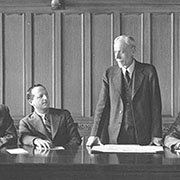CANADA HISTORY
Woodsworth and the CCF

The collapse of the stock market in 1929 triggered a wave of economic devastation across the globe, and Canada was no exception. As unemployment soared and businesses shuttered, most Canadians turned to traditional political parties to express their discontent. The Liberals and Conservatives had dominated Canada’s political scene since Confederation, with little room for third-party movements. However, the economic collapse exposed the limitations of these two parties in dealing with the widespread social and economic crises that emerged during the Great Depression. For those on the left, the political landscape offered even fewer options. There was little interest in the Communist Party, led by Tim Buck, which seemed too radical for most Canadians. Meanwhile, J.S. Woodsworth, a respected figure in progressive politics, had no real party structure or platform to coalesce a movement.
It was in this context of economic collapse, widespread unemployment, and a sense of disillusionment with traditional politics that the Co-operative Commonwealth Federation (CCF) was born. J.S. Woodsworth, a pioneering figure in Canadian social democratic thought, realized that in order to have any meaningful influence on the political scene, a unified effort among progressives, labour activists, and farmers was required. On July 22, 1933, Woodsworth and a group of like-minded reformers convened in Regina to found the CCF, and the Regina Manifesto was crafted, setting out a bold vision for social and economic reform in Canada.
The Creation of the CCF and the Regina Manifesto
The Regina Manifesto, adopted at the first convention of the CCF in 1933, was a visionary document that called for sweeping changes to Canada's economic system. It advocated for the nationalization of key industries, including transportation, electrical power, communications, and banking. The Manifesto sought to transform Canadian society through a cooperative approach to economics, which included a focus on labour rights, fair wages, public ownership, and social welfare programs like unemployment insurance and healthcare. The Manifesto was, in many ways, a radical departure from the capitalist framework that had defined Canadian politics for decades. It rejected the existing system of capitalism, which it viewed as having failed the working class and rural populations. It also emphasized the need for the state to play a central role in managing the economy to prevent exploitation and inequality.
The CCF was unique because it brought together a broad coalition of groups and individuals from across the political left. This included labour unions, farmers, intellectuals, and professionals, all of whom were frustrated with the status quo. These groups coalesced around a shared desire for a more equitable distribution of wealth and government intervention to protect the most vulnerable in society. The Manifesto's call for public ownership of industry, while controversial, was supported by many who felt that private corporations had too much power and were responsible for the economic collapse.
Despite the CCF’s broad coalition and ambitious platform, many Canadians were wary of the party's resemblance to socialism or even communism. The fear of radical left-wing movements, especially during the 1930s, was widespread not only in Canada but across the Western world. Tim Buck, the leader of the Communist Party of Canada, even suggested a united front between the CCF and the Communist Party. However, Woodsworth was quick to reject this idea, understanding that any association with communism could prove disastrous for the CCF’s chances of gaining mainstream support. In a famous statement, Woodsworth declared, "A real united front involves an agreement on fundamentals and a belief on the part of each co-operating group in the sincerity of the other group. In tactics at least there is no agreement whatever between the Communist party and the CCF."
The Early Electoral Challenges of the CCF
Despite the momentum generated by its creation, the CCF struggled to make significant electoral gains in its early years. Its first major test came in the British Columbia provincial election of 1933, where it emerged as the official opposition, marking a significant achievement for a new party. Similarly, in Saskatchewan, the CCF became the opposition, demonstrating that its platform resonated with voters in the prairie provinces, where the Depression had hit hardest. However, in more populous and industrialized provinces like Ontario, the CCF made only limited headway.
The 1935 federal election was another early test for the CCF. Although the party only won seven seats in Parliament, it marked the beginning of the CCF's presence on the national stage. Woodsworth, who remained steadfast in his commitment to the party's principles, refused to compromise the CCF's platform for electoral gain. He maintained that the CCF was a movement of ideas and policies, rather than a typical political party that might water down its platform for broader appeal. This ideological purity set the CCF apart from the other parties, but it also limited its immediate success in federal politics.
The Influence of the CCF on Canadian Social Policy
As the Second World War drew to a close, it became clear that many of the CCF’s policies, particularly those related to social welfare, were gaining traction with the Canadian public. The Liberal Party, under the leadership of Mackenzie King, recognized the popularity of many of the CCF's social programs, including old age security, unemployment insurance, and universal healthcare. King, who had long considered himself a reformer, began to co-opt these policies as part of the Liberal platform, a move that many historians credit with helping to create Canada's modern welfare state.
The CCF’s most significant and lasting influence on Canadian politics is undoubtedly its role in laying the groundwork for the social safety net that exists today. The party’s commitment to publicly funded healthcare, for example, was eventually realized through the efforts of Tommy Douglas, the CCF Premier of Saskatchewan. Douglas pioneered the Medicare program in Saskatchewan, which would later become the model for the national healthcare system. The CCF’s vision of economic equality and government intervention to protect the welfare of citizens became an integral part of the Liberal Party’s platform, blurring the lines between the two parties in the eyes of many voters.
Decline and Transition: The Birth of the NDP
Despite its influence on social policy, the CCF began to falter in the 1950s. Accusations of communist sympathies, though largely unfounded, were enough to discredit the party in the eyes of many voters, especially during the height of Cold War tensions. The CCF's popularity waned further after it passed the Winnipeg Declaration in 1956, which represented a move toward a more centrist philosophy. The declaration called for a more moderate approach to government intervention and emphasized working with business rather than opposing it outright. While this shift helped to stabilize the party's support base, it alienated some of the CCF's more radical elements.
In the 1958 federal election, the CCF suffered a devastating defeat, winning only eight seats. The overwhelming success of John Diefenbaker's Conservatives in that election left the CCF scrambling to reassess its future. Many former supporters turned to the Conservatives, seeing in Diefenbaker a populist alternative to the entrenched Liberals and a change from the political status quo.
The CCF’s decline in the late 1950s prompted party leaders to seek a new direction. Recognizing that labour was an increasingly important political force, the CCF began to forge ties with the Canadian Labour Congress (CLC). This partnership culminated in the formation of the New Democratic Party (NDP) in 1961. Under the leadership of Tommy Douglas, the NDP sought to rebuild the CCF’s base by appealing to labour unions, social activists, and progressive voters. The NDP maintained the CCF’s commitment to social democracy but adopted a more pragmatic and moderate approach to governance.
Conclusion: The Legacy of the CCF in Canadian History
The creation of the CCF in 1933 was a watershed moment in Canadian political history. Though the party struggled to achieve electoral success in its early years, its influence on Canadian social policy was profound. The Regina Manifesto laid the groundwork for the creation of a welfare state in Canada, and the CCF's policies on public healthcare, unemployment insurance, and old age security were eventually adopted by the Liberal Party, helping to shape the modern Canadian social safety net.
The CCF’s commitment to principled politics, even at the expense of short-term electoral gains, set it apart from other parties of the time. While this ideological purity limited its initial success, it laid the foundation for the eventual success of the NDP, which continues to play a significant role in Canadian politics today. The CCF’s legacy is one of progressive reform, social justice, and a belief in the power of government to improve the lives of its citizens—a legacy that has had a lasting impact on Canada’s political and social landscape.
Cite Article : www.canadahistory.com/sections/documents




